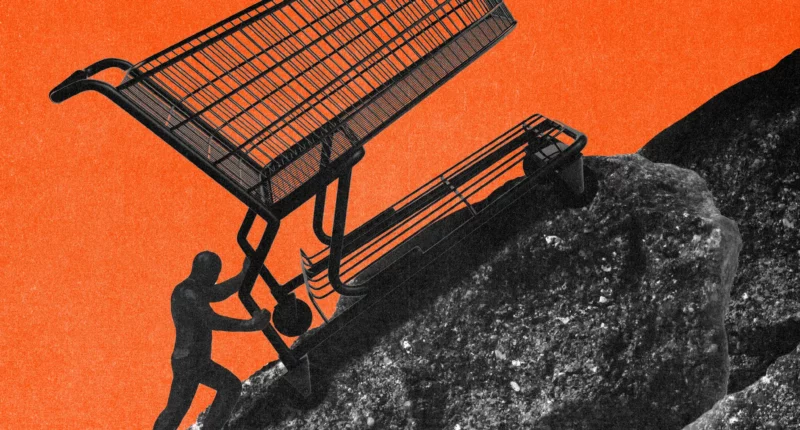The economy is growing. Wages are up. Unemployment is low. Income inequality is narrowing. The fearmongering about inflation proved to be, well, wrong. According to many economy watchers, Americans should be sending the Biden administration a gift basket full of positive vibes — and votes.
Instead, consumer confidence polling paints a different picture. A recent Times/Siena poll found that only 2 percent of registered voters said economic conditions are “excellent,” and only 16 percent said they were “good.” While economic indicators suggest that the economy is healthy and growing, the American public doesn’t feel that way. Why the perception gap?
One popular theory is that media narratives have duped Americans into believing that they’re having a rough time, when, in fact, they’re doing fine. Kyla Scanlon coined “vibe-cession” last year to describe this gap between perception and economic indicators. Since then, a story has emerged about consumer confidence: that poor perception and political polarization are mostly to blame. Brian Beutler, who writes the newsletter Off Message, calls out social media and misinformation for reinforcing the “bad economy” belief. Claudia Sahm, a former Federal Reserve economist, wrote that a “toxic brew” of human bias for negative information and the attention economy leads to consumer pessimism.
The Biden administration’s messaging about the strength of the economy will shape President Biden’s 2024 campaign. If Americans’ negative vibes about the economy persist, Donald Trump will surely bludgeon Biden with a line of attack that he relishes delivering. One of Trump’s favorite claims is that he is a successful businessman who ran a strong economy as president. Too few people believe that Trump, the G.O.P.’s favored candidate, will go to prison between now and the 2024 election. And so it should worry Biden that, according to that Times/Siena poll, a majority of likely voters trust Trump more than Biden on the economy.
Why aren’t more voters giving Biden credit for his strong economy?
The bad vibes explanation is sound on the indicators, but that story doesn’t think too highly of Americans. It does not acknowledge voters’ dissatisfaction. It also does not offer a way forward. What do you do about bad vibes, exactly? Hire an exorcist?
Looking at the economy through more than macroeconomic indicators could tell us a more compelling, empowering story. What if people are not manipulated by the media, confused about the fundamentals or biased against Democrats? What we know about historical changes to how the economy works and for whom it works might tell a different story with more potential for the future.
One such story considers what we consume and how much harder (and expensive) it is to procure it. A lot of our consumption is about meeting our basic needs. Housing, food, and energy come to mind. The economic fundamentals on these may be trending positively, but the bad vibes narrative undersells how miserable that part of the economy can feel.
People are struggling with mortgage interest rates, housing shortages and pricey grocery bills. They’re also consuming to make their lives work: on expensive, hard-to-manage child care, health care and convenience spending — things like restaurants, travel, delivery services and on-demand help — which are necessary for balancing work and life demands. Even when those services are affordable, they are full of friction. That is a nice way of saying the consumer experience sucks. It is hard to schedule things, hard to get customer service, hard to judge the quality of what you are buying and hard to get amends when an experience goes bad. There is a reason industry analysts have reported that customer brand loyalty is low and customer rage is high.
In 2021 the American Rescue Plan created a temporary social safety net for millions of Americans that may have changed how they feel about their spending. For younger Americans, the massive stimulus was a taste of the Great Society investment that benefited their grandparents and great-grandparents. Child care subsidies, direct cash transfers, food supplements, eviction moratoriums and flexible work-from-home arrangements temporarily lifted many low-income people out of poverty. Those provisions also exposed many working and middle-class workers to the difference that economic policy could make — for the better — in their lives.
Then, fearing inflationary pressures on the economy, Congress let the American Rescue Plan’s most powerful investments, the most substantial government support for social reproduction in a generation, end. But social reproduction — the caretaking of people, relationships and systems that make our society work — still had to be done. Reallocating your spending from child care to student loan payments, for example, might be feasible, but it is not particularly enjoyable. That assumes one can find accessible child care or an in-network doctor or apartment. When stimulus funding ended, a lot of services people rely on became harder to find and afford.
When people talk about the work that makes the economy possible, they often think first and most about child care. There is a good reason for that. Child care is necessary work. It is often unpaid work (when done by mothers) or underpaid work (when done by child care workers). The American Rescue Plan sent $39 billion to states, with the aim of stabilizing child care centers. After some of that funding expired in September, the problems typical of our country’s child care shortage re-emerged. Depending on where one lives, child care centers’ capacity may not have returned to prepandemic levels, producing a lot of anxiety and wait lists for families. As one of my colleagues recently put it, anyone who thinks he just has bad vibes hasn’t tried to find summer day care for young children.
Then there is the rest of the hidden labor that has to happen so people can go to work, that is so often invisible and that has historically been the domain of women: caring for a household and aging relatives, receiving the plumber or delivery truck and, of course, having the time (and money) to make meals, manage doctors appointments, chauffeur kids to after-school activities and clean the house.
For the most part, the industries that support that kind of invisible labor are more difficult to find, harder to obtain and more expensive to buy than they were four years ago. Those industries also gained a lot of not-so-enjoyable friction. Industry surveys suggest that customer service has gotten worse and consumers are angry about it. That coarsening of consumerism affects millions of people, and women, in particular, pay a price due to the outsize role they play in managing hidden labor.
Jessica Calarco, a sociologist at the University of Wisconsin, calls the way our society relies on families to independently support social reproduction a “D.I.Y. society.” Research demonstrates repeatedly that women, especially, are sacrificing to balance paid work with all that D.I.Y. labor. Healthy economic indicators, like low unemployment, also put the squeeze on women by raising the price and increasing the difficulty of hiring a little help.
The bad vibes story emphasizes that lower-income workers have benefited the most from the growing economy. It is true. Over the past four years, at the macro level, workers at the bottom of the income distribution made greater gains than those at the top. That wage compression means some good things, for example: People without college degrees are benefiting from a strong labor market. The female-dominated child care field is a good example. Acknowledging that child care is skilled labor empowers the workers to demand better working conditions.
However, those positives also present a challenge. To use child care workers as an example again: As their wages stagnated and their skills upgraded, many of them left for better-paying jobs. That is the case for a lot of the jobs that do the vital social reproduction work in our economy. There are now fewer people to do the low-paid, low-status work than there were before the Covid-19 pandemic. Illness pushed some workers out. Others left for better economic opportunities. The social reproduction work needs to be done, but there are fewer workers able or willing to do it.
Low unemployment means more Americans are working. It also means more people are experiencing our social reproduction crisis firsthand. This has long been a reality for female workers. Our crisis of who is supposed to do all the undervalued labor that underpins economic life has pushed many women out of the work force, reduced their participation and generally made work more stressful. Men now take on moderately more responsibility for household tasks. With that shift, the problem of balancing care work and paid work has become urgent for both men and women. Even as millions of Americans are earning more, they face stiff competition from high-income earners for a smaller pool of services — including schools, health care, home maintenance and retail services — to make it all work.
In short, people may have more money. But it has become harder to buy the services they need and more expensive to buy the goods that they want. The very wealthy can spend their way out of that bind simply by paying more for housekeeping and grocery delivery and nannies. But everyone else needs some sort of partnership with the government to make the act of working not just affordable but also accessible. The Biden administration has not solved that bigger crisis. (Neither did the Trump administration.) Whether Americans are blaming the right administration for their woes, their economic lives legitimately feel tougher even as they work more and earn more money.
Bad economic storytelling says to millions of Americans in an election year that they only think that they are struggling financially. Good economic storytelling would figure out how to account for their experiences and imagine a better future. People need child care and dentists and affordable housing and safe transportation and accessible education. Telling them to instead enjoy the fact that they can buy a Tesla is a fundamental misunderstanding of what economic policy is supposed to do, which is to make people’s lives better.






